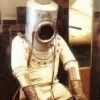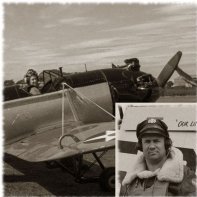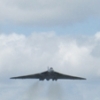Search the Community
Showing results for tags 'avro'.
-
Valom is to release 1/72th Avro Anson kits. I've a dream: 1/48th scale kits from these Annie variants. Sources: https://www.facebook.com/www.valom.net/posts/pfbid0SPStYqHcJADwndhbhhuWyde1msKW457YawkkqoukKvXMSnwGxE9kpnvdXFofYek5l https://www.valom.net/?page_id=1137 - ref. 72164 - Avro Anson C.19 - ref. 72165 - Avro Anson T.21 V.P.
- 73 replies
-
- 20
-

-

-
Anson Mk.I Guns & Lewis 97 Magazines (648844 & 648861) 1:48 Eduard Brassin PRINT We reviewed the newly tooled 1:48 AVRO Anson from Airfix here last year, and it’s a great kit that has made many WWII modellers very happy. Eduard’s new Brassin PRINT sets brings superb detail to the light armament that the Anson sometimes carried, despite it not being a combat aircraft, and that armament is how Faithful Annie achieved its only kill of WWII, when a brave gunner took out a Bf.109 in a lucky/gutsy attempt to keep the enemy from downing the aircraft he was in. There are two sets, one provides the three Lewis guns that were fitted in various locations around the airframe, the other provides extra magazines to fill the racks near the mounts for reloading purposes during a fight or weapons training. Both sets arrive in clear-fronted Brassin vacformed boxes, with the header card and instructions at the rear, whilst the 3D printed resin parts inside are safely stored inside a crystal-clear plastic clamshell box that sometimes has a sticky pad in the bottom to prevent the parts from rattling around the little box. Anson Mk.I Guns (648844 for Airfix) Printed on three bases, there are three incredibly well-detailed Lewis guns and one barrel for fuselage mounting, all of which far outstrip the finesse of the kit parts, and include their mounting posts, plus a half-dozen magazines, none of which will be needed to arm the guns in their emplacements. The small Photo-Etch (PE) sheet contains a vane sight for one of the weapons with a spare, and each gun mounts on the styrene parts from the kit, removing one kit gun that is moulded into its mount, and drilling out two 1.1mm holes to accept the uprights. Lewis 97-Cartridges Ammo Magazines (648861 for Airfix) This set contains one printing base that holds a dozen additional magazines for either your Anson model, or any other Lewis gun installation that accepts the ‘dinner plate’ style magazines, which all have their grab-handles printed integrally, just needing painting a red brown colour to represent leather. Conclusion The detail alone will bring extra realism to your model, with finer barrels and sighting equipment, with more detail squeezed into every square millimetre of the surface. Very highly recommended. Review sample courtesy of
-
BCATP Ansons – British Commonwealth Air Training Plan (48042) 1:48 Iliad Designs Originally designed as a fast mail carrier in the early 30s, the original AVRO design was amended in the mid-30s in response to a specification issued by the Aviation Ministry for a reconnaissance aircraft that could also perform other roles. It beat a similarly militarised De Havilland Rapide and was awarded a contract for series production with the name Anson after an 18th Century Admiral of the Fleet. At the outbreak of war it was still performing its given roles, and was engaged in the Dunkirk evacuation where it surprisingly managed to shoot down two Bf.109s and damage another, as they found the low speed of the Anson hard to gauge, overshooting straight into the line of the nose-mounted .303 machine gun operated by the pilot. She was thoroughly outclassed as a front-line aircraft though, so was soon withdrawn from fighting service to form part of the training fleet, and as a communications ‘hack’. Despite its withdrawal from service, more aircraft were built, and they were used as trainers for radar operators, navigators and as a trainer for pilots that were destined to fly multi-engined bombers. Its replacement in maritime service was the Lockheed Hudson, which had a hugely increased range and speed, the Anson only being capable of a four-hour endurance that prevented it from covering much of the Atlantic or North Sea before it had to turn for home. It could carry a small bomb load however, so could take action if it was to find a U-boat on its travels. Following WWII, Faithful Annie as she became known was used as a civilian and business aircraft, although some of the wooden-winged examples that were used overseas began to suffer from problems due to the humidity’s effect on the timber areas. Not all Ansons had wooden wings though, and some of the wooden winged aircraft were refitted with the improved metal wings, although even these were eventually retired, leaving only one airworthy by the new millennium. This new decal set from Iliad in Canada depicts a variety of airframes in the service of the British Commonwealth Air Training Plan, training aircrews for the fight in Europe. The sheet arrives in a Ziploc bag on with the decals printed on an A5 sheet of decal paper. There are six decal options included on the sheet with side and top profiles printed on the instructions along with captions and arrowed areas that give additional details to help you make your model more accurate. They are intended to be used with the new Airfix kit, which is the new standard in 1:48. There is an older kit from Classic Airframes in 1:48, but the kit is a much more complex build and only available on the second-hand market. The decals would likely fit though, as they aren’t contoured particularly to any part of the model. The top and bottom profiles are small but able to show sufficient detail to be useful, and these too have detail painting call-outs where necessary. From the sheet you can decal any of the following: Anson Mk.I, 6077 (ex R9878), No.7 AOS (Air Observers School), Portage la Prairie, Manitoba Anson Mk.I, 6117 (ex R9956), NO.4 AOS, London, Ontario Anson Mk.I, 2115 of No.6 AOS, Prince Albert, Saskatchewan Anson Mk.I, 6013 (ex RAF N9943), Camp Borden, Ontario Anson Mk.I, 9982, No.6 AOS, Prince Albert, Saskatchewan Anson Mk.I, 6067 (ex R9835), Prince Albert, Saskatchewan The decals are printed on a pale blue paper in good registration, sharpness, and colour density, with a thin gloss carrier film cut close to the printed areas. There are some large areas of carrier film between the lettering by necessity, but due to the extremely thin nature of the film it should disappear, especially if you ensure a highly glossy surface before application. Highly recommended. To pick up your set, visit the link below, scroll down, and follow the instructions for purchase Review sample courtesy of
-
The bench is cleared for a commission build of a 1/32 HK Avro Lancaster Type 464 in Operation Chastise mode. Have to be honest, the box picture is more exciting than the opening of the box. The well documented poor HK packing was evident but everything was thankfully in one piece. Two nice instruction books, one for the standard MkI/III build and another with the special bits for the Dambuster build. Also a nice little extra a little book called "Rad Shutters Auto" by Stuart Reid, a former BBMF pilot. Nice little touch. The failings of this kit are well documented but, I love a challenge and it was the only option really. My client wanted a Dambuster aircraft and, of course, the Border model is a ferrari against a ford in their base state but there are no Border Lancs about at the moment and God knows when or if a 617 squadron one will come along. With lots of work, reshaping, scratch building, tons of research, ( I'm about 30 hours of research in already and still only sorting out cockpit layout, there's a brilliant kit to be built. The floor for the pilot's seat has to go, it's way too high and misshapen. Pilots seat is very poor but a resin one from Resin 2 Detail is in the post and the IP is frankly, disgusting for a £300+ kit. Thank the Lord for Peter and Airscale. Their IP arrived today and, as ever, it's superb. Also got one of his new branch out of seatbelts for the pilot's seat, they look more RB than HGW. I'll get that made up tomorrow. The eyes will suffer for that one! Spot the deliberate mistake BTW? I've gone and ordered the Sutton harness in 1/24 instead of 1/32 Still, it'll be fine for the new spitfire in the autumn So today, the horrid box construction that the pilots seat sits on has gone, I'll reuse some of it for height but it needs a total reshaping before that. The engineers panel has been filed smooth ready for the Airscale PE plate. I've removed the two little star shaped knobs first though for further use. Go in through the back with a ball cutter and they just pop out. Thanks to Nigel at Nigel's modelling bench for that one. Used it on the Hellcat too. I've made up the pilot's seat too just to get a feel for the fit and hardness of the plastic although I won't be using it. That's about it for now, got a trip to Lincoln at the weekend and maybe a detour to look at a Lancaster.........
-
In Autumn 2022, Airfix is to release a new tool 1/48th Avro Anson Mk.I kit - ref. A09191 Source: https://uk.airfix.com/products/avro-anson-mki-a09191 V.P. For me a Avro Anson C.19/T.21 in the same scale. 🙏 V.P.
- 210 replies
-
- 24
-

-

-
Avro Lancaster B.II ( A08001) 1:72 Airfix The Lancaster is without doubt one of the most famous aircraft ever to fly and became the back bone of Bomber Command alongside the Halifax in the latter half of WWII. Development was born out of failure in the guise of the Avro Manchester to which history has been unkind because of the unreliable Vulture engines. Convinced that the basic Manchester airframe with an unobstructed full width bomb bay was basically sound, Roy Chadwick and his team designed the Type 683 Manchester III which used a larger wing supporting 4 Merlins. From the start, the aircraft proved Chadwick right, requiring only minor modifications for operational service. The cleverly designed bomb bay meant that the Lanc could carry a 14000lb conventional bomb load but with some modifications could even lift a 22000lb bomb which was unheard of at the time. With over 7000 Lancasters serving in WWII, most were indeed powered by the legendary Merlin. With a risk of Merlin shortages, a design was tested using the Bristol Hercules radial engine which led to one of the most visibly unique variants to operate, the B.II. Whilst the Hercules was more powerful, it had a slightly inferior service ceiling meaning that they generally flew lower than the Merlin variants during raids putting them at greater risk. This contributed to a 60% operational loss although they had a slightly faster cruising speed and rate of climb. All together, 300 B.II’s were produced, operating mainly with the RCAF which used it to replace Wellington bombers. B.II’s were eventually replaced by Merlin variants although a few went on to become test beds. The Kit Until Airfix's new tol B.II arrived in 2013 the only way to build a B.II was using a conversion kit, The kit is nicely moulded, and while Ive seen finer panel lines in my time as a reviewer, the panel lines on the external surfaces of this kit dont stand out as being over done. The overall shape of the model looks good and I haven't heard any complaints of significant shape errors since the original versions of the kit were released. Construction starts with the interior, which is very well detailed. The roof of the bomb bay and the spars for the wing must be assembled first as the rest of the model builds up around this core structure. The bomb bay itself is very nicely detailed, although youll need to provide your own ordnance or purchase the Bomber Re-Supply Set. Onto this part are added the spars for the wings. The spars form internal bulkheads at their centre, and extend as far as the main landing gear bays in the inner engine nacelles. The flight deck is comprised of a raised floor, a two-part pilots seat, a folding seat for the flight engineer, a control column and a two-part instrument panel. Forward of the cockpit is the bomb aimers position, for which a nicely moulded bomb sight is included. Aft of the cockpit are the navigators and radio operators stations. Sidewall detail is moulded in place on the inside of the fuselage halves and in my opinion it looks excellent. The fuselage window glazing must be installed at this stage too. Once the fuselage halves have been joined, assembly moves on to the wings. The next few steps in the construction process are either clever or complex depending on your point of view. The two wing spars mentioned above aid with the alignment of the wings and strengthen the structure of the model, but they also form the fore and aft walls of the main landing gear bays. To complete the structures, you need to add the rib and frame details which run parallel to the fuselage. The end result should be a pair of landing gear bays which are superbly detailed as well as nice and strong. The ailerons are moulded in place but the landing flaps are separate assemblies, and very nice they look too. The elevators and rudders are all moulded as separate pieces and so can be posed in a variety of positions if so desired. The engine nacelles are fairly simple in just two halves. The struts which connect the landing gear doors to the undercarriage legs are moulded in place. This means that, should you build the kit with the gear down, you should be able to achieve a good, strong fit at the first time of asking. If you wish to build the kit with the gear up, then you just need to cut them off. I really like this approach and I hope it works as well in practice as the instructions suggest. The landing gear legs themselves are well moulded and nicely detailed and the wheels have flat spots moulded in place The radial engines are built up from two cylinder banks , these are installed onto the nacelles. then the three part cowls go on followed by the props. The exhausts go on the sides. All that remains to do at this stage is to add a few small parts such as the DF loop and elevator actuators, the propellers and the transparent parts. Airfix have suggested that you assemble the turrets last of all, but you could just as easily build them at the outset and set them to one side. The frame lines on the transparent parts are clearly marked. Decals Decals are by Cartograf so will pose no issues. A choice of two schemes is provided on the decal sheet: LL725 – ‘Zombie’ EQ-Z of 408 ‘Goose’ Sqn, RCAF based at Linton-on-Ouse, 1944 DS842- ‘Fanny Ferkin II’ of 514 Sqn, RAF based at Waterbeach, Cambridgeshire 1944 Conclusion Airfix's Lancaster is nicely detailed, superbly engineered and widely available (in the UK at least). The price is pretty reasonable too. The only grumble concerns the lack of ordnance, which has been debated on this very forum. That aside, this is an excellent kit and Airfix should be commended for doing the B.II as well as the B.III. Highly Recommended. Review sample courtesy of
-
I'm not doing anything fancy to this one, a nice somewhat simple kit. I started this about a week ago and well, i'm already at the painting stage (almost) so a bit of a catch up is needed. Cockpit Its fairly empty in here but i couldn't be bothered to do anything. I used Milliput to block up the holes in the side for the wing fitting. I used interior green mixed with a little bit of RAF dark green to darken it up a little bit, i also used a sponge and silver to imitate chipping. As i didn't have any blue, i had to use green (can't remember what type) for the crews uniform, along with various other colours. i painted the instrument panel and radio black with white dots to show dials. The build First of all, i adore the retractable gear system on this, it has this feature while retaining a fairly accurate look. The whole thing needed sanding an filling on practically all the seams. The cowling had a nasty ridge going all around it, but was an easy fix. The masking on the canopy is pretty bad, there was no framing. Not much to say about this to be honest.
- 20 replies
-
- 10
-

-
Dixit a post in French forum Master194, after last year Argosy (http://www.britmodeller.com/forums/index.php?/topic/234990603-172-aw-argosy-mach-2/) Mach 2 is to release at Telford SMW 2016 a 1/72nd Avro 685 York kit - ref. GP079, GP080, GP081 & GP082 No more details known for the moment. See also Mikromir same project: http://www.britmodeller.com/forums/index.php?/topic/235011331-avro-york-172/ Sources: http://www.master194.com/forum/viewtopic.php?f=3&t=95530 https://www.facebook.com/1098581226825624/photos/pcb.1524328597584216/1524325614251181/?type=3&theater V.P.
-
Happy Birthday Royal Air Force Today is the 102nd Anniversary of the formation of the Royal Air Force. Two years ago - to the day - I started building this model of an Avro 504K. My intention was to mark the centenary of the Royal Air Force's formation by building an example of an important aircraft that had served in the RNAS, RFC, RAF and many of the commonwealth air arms that followed. It's just as well I remembered the commonwealth because it turns out there's a very good chance that in 1918 this particular airframe was actually in service with the AFC (Australian Flying Corps) and not the RAF at all. This, despite my strong attachment to Australia, was not my intention. It seems a dodgy reference book might have let me down there, but that does not matter to me really, I still think that this model of an Avro 504 fits the original purpose. I finished the model yesterday and in doing so completed the project just one day inside a self-imposed deadline of two years. This project is, by far, the most challenging and technically difficult model I have ever attempted. It's 100% scratchbuilt, mostly from wood but with significant amounts of brass and plastic. There are no purchased parts at all (well actually there's one tiny kitset piece scavenged off a Tamiya kettenkraft) so everything you see is hand made. There is no 3D printing used. It's mostly done the old fashioned way of solid model building with the fashioning of all of the large parts starting by running a bit of wood through a bandsaw. I'm an old fashioned kind of dude at heart and gain a certain satisfaction from the belief that I'm keeping some old-time skills alive in this nutty modern world. If you would like to have a look at how this model was put together, please click on this link... The project is not completely finished just yet. Sadly, right now, there's a silver plaque sitting in an engraving shop in Perth reading 'Avro 504K, RNAS, RFC, RAF' but I can't go and get it because that journey into town is not deemed essential. When next I can get into town, I'll pick the plaque up and attach it to the side of the display base's frame and then this project will be wrapped up for good. This build has made me extend my skills in many different areas and I believe I come out of the experience a better modeller; more confident than I was that I can handle technically challenging subjects. I'm not lining up to do a biplane any time soon but I won't rule out doing something like this again some time. For now however, I already have some research into the SS Xantho happening on the maritime pages and if you want to see some more Bandsaw action very soon, keep your eyes peeled in the military section. I've got something starting up in there that's about as far away from a WW1 biplane as can be imagined. Anyway - enough of that. There's not much left to do except thank everyone who commented, suggested or contributed to the Avro 504 WIP thread in any way at all. I fear I'm actually a bit vain and always get a small kick out of scoring a 'like' or a 'happy face' and watching my 'reputation tally' go up. Without the ongoing interest and support of the Britmodeller community I am unsure that I would have bought this to a conclusion. So thank you everyone, including the mods and admins and tech folk who make the site run and keep this a great spot to hang out. Here's some photos - I hope you enjoy them. Best Regards, Bandsaw Steve
- 33 replies
-
- 61
-

-

-
Happy Birthday Royal Air Force Today is the 100th Anniversary of the formation of the Royal Air Force. If you did not know that already you are probably on the wrong website. Some time ago I decided that I wanted to mark this occasion by starting a new project on this date and have of late spent much time thinking about what the subject should be. Naturally enough, Spitfires, Hurricanes, Lancasters and myriad of famous post-war types all came to mind, but these are well-covered subjects and so I dwelled on the matter a bit deeper... What about something that was in service on the day the RAF formed? What about something that had served in both the RFC and the RNAS prior to the formation of the RAF? What about something that was crucially important both to the newly formed air force and essentially all of the commonwealth air arms that were to follow? What about the Avro 504! To me, the Avro 504, more than any other single type, captures the spirit and the essence of the nascent Royal Air Force. This type had seen service as a fighter, a bomber and reconnaissance aircraft prior to being 'relegated' to the training duties at which it excelled. By 1918 this was the most numerous aircraft in the RAF (and probably in the world) with more than 7000 being built during World War One alone. In the new air force almost all aircrew had been trained on this type and I should think most of the ground crew as well. It was the foundation of the skills and professionalism that have been the hallmark of the service ever since. So, foolishly, I'm going to have a crack at building one in 1/32 scale. Here are the plans I will be using...provided most efficiently by Len Whalley at 'aeroplans.co.uk’ (Great service thanks Len). As you can see this is a screen-shot of my electronic copy because my friendly computer draftsman at work is on extended Easter holidays. He'll be back soon! In the meantime I'm going to use these plans as a starting point, they are fine for the general layout and dimensions. And here we go... Start with a good straight, clean bit of wood. In this case I'm using Jarrah - just like I did in my Mig 15 build here... www.britmodeller.com/forums/index.php?/topic/235012524-mig-15-scratchbuild I'm using Jarrah mostly because it's the strongest wood I can get hold of. Having studied the plans I can see that there are going to be some challenges with maintaining the structural integrity of this model, especially once the extensive cockpit has been hollowed out - hence structural strength is going to be a major consideration. It's a beautiful bit of wood this - straight close grain almost flawless. The oval below marks the only knot in the entire plank, it's tiny and is fortunately positioned so it can be easily excluded from the fuselage cut-out. Here I'm marking off the first cut for the fuselage. I'm cutting it much longer than it needs to be for reasons you will see later on. And here it is - the first cut - made on 01 April 2018! Hooray... Two lengths have been cut for the fuselage so that I can work to the natural centre-line thus formed... The wings are being cut from some thin slices of sapelli. Another high-quality hard-wood. I've chosen this because I do not want the wings to sag and think that sapelli will be rigid enough to hold it's shape over time. And here's the rough cut-out of the tailplanes. I think that the tail is going to be the only easy part of the build. And so -after 20 minutes of work I have the very, very rough outline of a biplane... No - this is not an April Fools joke, this really is the start of my model! I don't know how long this is going to take but given the slow pace of my previous (still uncompleted) project that you can see here: www.britmodeller.com/forums/index.php?/topic/235021633-hmasm-ae2-scratchbuild I would say this will take at least a year and possibly much longer. I've never built a biplane before. Wish me luck... Best Regards, Bandsaw Steve (ex-Reconcilor)
- 784 replies
-
- 32
-

-
- Scratchbuild
- Avro
-
(and 1 more)
Tagged with:
-
Aircraft in Miniature ltd. is to release a 1/48th (and also in 1/72nd) Avro Blue Steel resin missile in its Rug Rat Resins range. Source: http://www.aim72.co.uk/page170.html Would be nice alongside my Aeroclub 1/48th Vulcan... or the Sanger one. V.P.
- 12 replies
-
- 1
-

-
- Aircraft in Miniature
- Blue Steel
-
(and 1 more)
Tagged with:
-
Hello, I would like to present my 1/72 Avro Rota C.30 in Swiss livery. RS Models kit out of box apart from the addition of PE seat belts. A quick build; nice little kit so I have another on the bench 😊 Thanks for looking Aaron
-
Welshmodels has just released a 1/144th Avro Tudor V resin kit - ref. SL439R Dual liveried kit of an Avro Tudor V in Lome Airways of Canada and Airflight Ltd. Full resin kits with metal props and undercarriage to complete. decals by Cranc. Source: http://www.welshmodels.co.uk/SL439.html V.P.
-
After the Mach2 (http://www.britmodeller.com/forums/index.php?/topic/235011263-172-avro-york-by-mach-2-release-november-2016/) kit announced for Telford SMW 2016, here's the Mikromir's 1/72nd Avro York kit project. Source: http://www.britmodeller.com/forums/index.php?/topic/235011331-avro-york-172/ CAD V.P.
-
Airfix is to release in 2014 a new Lancaster variant in 1/72nd, the Avro Lancaster BI(F.E.)/BIII - ref. A08013 V.P.
-
Reading in the local paper an article on a mysterious airstrip near Bognor, which it turns out was built in 1946 by the Lec Refrigeration co. for their reps, who used to fly Miles Gemini and Austers to meet clients! Those were the days... in 1957 they bought an Avro Anson for use as a flying fridge and freezer showroom. When you think about it an Anson is ideal shape for fridges, although the sloping floor might have been interesting. Now there's an obscure modelling subject!
-
Hello fellas. Fellas. I have quick question. Finishing build of Avro Shackleton and to be honest, I do have some problems to find right colour or lets say, mix proper colour. Not using revell colours. And I just bought Tamyia XF-82 which is Ocean grey 2 (RAF). Will it be OK for that model?
-
- Avro
- Shackleton
-
(and 1 more)
Tagged with:
-
Yesterday, I was watching Raiders of the Lost Ark and it was quite appropriate because today I collected the Holy Grail of Bomber Command modelling, the 48 scale Paragon Manchester conversion! Before I go any further, I can't thank to Dennis (Spitfire) enough for selling it to me without needing a mortgage to afford it, so I intend to do it justice and have it done for Telford. Whilst I'm at it, I'm also doing the Paragon 1/48 Lincoln conversion with an equally big thanks to Chris (Cngaero) who sold that to me for an equally reasonable price, that's 2 Christmas's so far this year and we're only in June! That will be published elsewhere in the future, so I can't show the full progress on that one, but will drop a few photo's in along the way. I recently build the excellent Blackbird Manchester & Lincoln conversions, as you may guess, I'm a big fan of Avro's line of props, but always wanted to do them in 48 scale, I just couldn't get hold of the damn resin! The Lincoln was started a few weeks ago, the resin quality is excellent... The base for both conversions is of course the classic but superb Tamiya Lancaster Now for the Manchester resin.....
- 235 replies
-
- 17
-

-
Hello for everyone. When an idea is presented, we analyze the feasibility and design technician solution containing all basic elements of the new product and new models project. I have the pleasure to welcome all modellers, guests, participants and friends to the fourth of my WIP here on a forum and to the new one topic. I am looking at the watch, getting a bit worried because I think it is necessary to inform you today about how I intend to approach the work on for the triple AVRO 707 assembly. To tell the truth, I really like a British aircrafts and jet fighters also. The first step is still created in the traditional way: - Open boxes; - Spare parts inspection for the general condition; - Read the manual; - Close the boxes and forget all above (especially text instruction content)... To be continue... Best regards. Andrii
- 61 replies
-
- 12
-

-
Anyone fancy a go at this? Vulcan XL319, in 2010 with snow overload. Or the recovery 10 days later.....
-
Hi all, With the Vulcan and X-Wing off the benches, and the Gnats driving me up the wall, it's time to start something else. So, the Lancaster is the next stop. The Revell 1/72 Dambuster to be more accurate. We have plenty of goodies for this build: A couple of sets of Master brass gun barrels, Eduard masking set for obvious reasons, Aires wheels, and Eduard seatbelts and cockpit photoetch set. I figured that a lot of detail will be seen through the green house on top of this kit, so I've gone to town. Nothing has happened to this build yet, other than washing the sprues as I seem to remember Phil Flory having a problem with release agent on his video build many years ago. After market Hannants Xtradecals are to be used with this build also: To be honest, I bought these decals for a 1/72 Tornado GR.4 project (I've not started yet), and these decals are part of the set. Seemed to make sense to use them. Hopefully we'll have a good time with this little lot! Cheers, Val
-
Good evening, first proper build post from me on the forums! Well it all started after a trip to the Midland Air Museum in Coventry where I got the fantastic chance to get inside an Avro Vulcan and see what it was like inside, and by god what an aircraft! I wish I had taken a lot more photographs but thanks to a thread that I found on the forums prior to joining, I found a nice walkaround inside of the cockpit. This was then followed by an enquiry to the Vulcan To The Sky Trust and after they gave me a few pages of the crew manual showing the details of both the front and rear cockpit, they also suggested getting a book which included the manual and infinitely more in-depth images. (The Vulcan Story 1952-2002 by Tim Laming) And so it began, all made of plasticard with the seat cushions made of milliput. Obviously there is still A LOT of work to do I think it is coming along nicely and the 3 panels shown at the end were made today with clear plastic used to serve as the ground scanning radar screen and a few dials. Thanks for that, cue the images! Sam And so after an hour of fannying around with Google+, Flickr and now Photobucket, the photos now work!
- 19 replies
-
- 10
-

-
Some of you may remember this Anson. It was submitted for the "Training Types" GB around 2 years ago, but not proceeded with. Well, I am back and on to it now, and I have found out some more about it! L9164 was the last British casualty of 18th August 1940. Those who know about the Battle of Britain, and readers of the book "The Hardest Day" by Dr. Alfred Price will be aware that this was the day of the greatest loss, by both sides, during the Battle of Britain. Anson L9164 was involved in night flying over RAF Windrush on the evening of 18th August 1940. It was attacked by an He111 of KG27 and both aircraft collided. It was suggested at the time that the pilot of the Anson, Sgt. Bruce Hancock, had caused the collision on purpose. No one will ever know as Sgt. Hancock died when his aircraft crashed. It is further alleged that Sgt. Hancock survived the crash but died later, and may well have survived had the search been organised earlier. Again we will never know. I do do not know what markings L9164 carried, but I have found some very useful photographs. Not of L9164, but of L9162 which is close enough. L9162 was one of 2 Ansons that were involved in a mid air collision over New South Wales, Australia, in September 1940. Although locked together, the 2 aircraft made a successful forced landing on the fields below, becoming known as the Brocklesby mid-air collision, named after the town over which the incident occurred.
-
This month Airfix are releasing their long awaited Avro Shackleton AEW.2 Model Kit in 1/72 Scale. This Cold War Era variant of the MR 2 was used as an Airborne Early Warning Aircraft, and this particular kit contains decals for "Ermintrude" and "Dougal" which flew with No.8 Squadron based at RAF Lossiemouth in 1979 and 1980 respectively. "Dougal" is currently preserved in the Museum of Science & Industry in Manchester, England. Place your pre-orders soon to avoid disappointment, this is going to be a popular kit!














